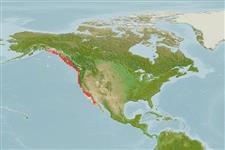Common names from other countries
Environment: milieu / climate zone / depth range / distribution range
Ecologia
marinhas demersal; intervalo de profundidade 9 - 547 m (Ref. 27437), usually 183 - ? m (Ref. 6885). Subtropical; 61°N - 27°N, 145°W - 113°W
Eastern Pacific: Yakutat Bay, Alaska to Rompiente Point, Baja California, Mexico.
Length at first maturity / Tamanho / Peso / Idade
Maturity: Lm 17.0, range 17 - ? cm
Max length : 38.0 cm TL macho/indeterminado; (Ref. 5483); Idade máx. registada: 38 anos (Ref. 39277)
Descrição breve
Morfologia | Morfometria
Espinhos dorsais (total): 13; Raios dorsais moles (total): 12-14; Espinhos anais 3; Raios anais moles: 5 - 8. Head spines strong to moderate - nasal, preocular, postocular, tympanic and parietal spines present, nuchals usually absent, supraocular and coronal spines absent (Ref. 27437). Eye large; 2 strong, sharp, hooked spines on lower margin of suborbital bone; 2nd anal fin spine longer than 3rd in depressed fin (Ref. 27437). Caudal fin moderately indented (Ref. 6885). Pinkish red to yellowish red, silvery ventrally; dusky saddles on back, may be vague; green streaks on caudal fin (Ref. 27437).
Mostly found in offshore water on soft bottoms (Ref. 2850). Ovoviviparous (Ref. 6885). Anterolateral glandular grooves with venom gland (Ref. 57406). Commonly caught with trawls but usually discarded because of its small size (Ref. 2850). Rarely taken on baited hook in deep water (Ref. 2850).
Ovoviviparous (Ref. 6885).
Eschmeyer, W.N., E.S. Herald and H. Hammann, 1983. A field guide to Pacific coast fishes of North America. Boston (MA, USA): Houghton Mifflin Company. xii+336 p. (Ref. 2850)
Categoria na Lista Vermelha da IUCN (Ref. 130435)
CITES (Ref. 128078)
Not Evaluated
Utilização humana
Peixe desportivo: sim
Mais informação
ReferênciasAquaculturaPerfil para aquaculturaEstirpesGenéticaElectrophoresesHereditariedadeDoençasProcessamentoMass conversion
ColaboradoresFotografiasStamps, Coins Misc.SonsCiguateraVelocidadeTipo de nataçãoÁrea branquialOutras referênciasCérebrosVisão
Ferramentas
Relatórios especiais
Descarregue XML
Fontes da internet
Estimates based on models
Preferred temperature (Ref.
115969): 5.9 - 8.3, mean 6.5 (based on 19 cells).
Phylogenetic diversity index (Ref.
82804): PD
50 = 0.5000 [Uniqueness, from 0.5 = low to 2.0 = high].
Bayesian length-weight: a=0.01000 (0.00499 - 0.02004), b=3.09 (2.92 - 3.26), in cm Total Length, based on LWR estimates for this Genus-body shape (Ref.
93245).
Nível Trófico (Ref.
69278): 3.7 ±0.5 se; based on size and trophs of closest relatives
Resiliência (Ref.
120179): Baixo, tempo mínimo de duplicação da população 4,5 - 14 anos (K=0.06; tm=4; tmax=38; Fec=15,000).
Fishing Vulnerability (Ref.
59153): Moderate vulnerability (43 of 100).
